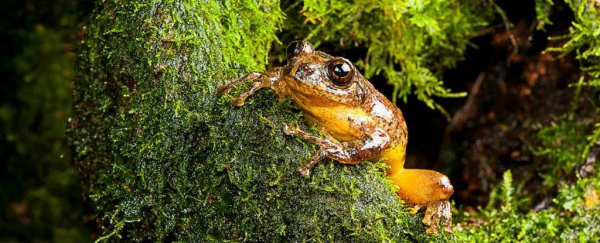A rare species of tree frog that consumes its mother's eggs has been rediscovered in the forests of northeast India, more than a 100 years since its first and only sighting in the wild. Nicknamed Franky's tree frog, this curious amphibian is so unique, it's now been assigned its own genus, thanks in part to the strange adaptations it's developed to facilitate its egg-feeding behaviour.
"We heard a full musical orchestra coming from the tree tops. It was magical. Of course we had to investigate," Indian biologist Sathyabhama Das Biju told BBC News. Known locally as 'The Frog Man', Biju is responsible for discovering 89 of India's 350 or so endemic frog species.
The species was first discovered in the forests of Darjeeling back in 1870 by British zoologist Thomas Jerdon, who collected the first and only specimens ever found of the species.
Originally named Jerdon's tree frog (Polypedates jerdonii), the species has been reclassified at least four times since its first sighting, National Geographic reports. But thanks to more recent DNA identification, it's now officially been renamed Frankixalus jerdonii.
Biju is now angling for its common name to be changed to Franky's tree frog, which honours his former university advisor, herpetologist Franky Bossuyt. (Bad luck, Jerdon. You had a good run.)
It's thought that the frog has stayed hidden all these years because not a whole lot of researchers have been working in the area. On top of that, the species makes a living out of staying hidden, keeping to holes in trees that are sometimes as heigh as 6 metres above the forest floor.
Publishing in PLOS One, Biju and his team describe how the females find these water-filled holes, and lay their eggs inside. Once the tadpoles have hatched, she'll continue laying unfertilised eggs in the holes, and her offspring will live entirely off these until they're old enough to find food for themselves.
Because of this strange survival mechanism - which recalls the creepy behaviour of these skin-feeding amphibians - Jerdon's tree frog has evolved some unique anatomical features. As James Vincent points out over at The Verge, most tadpole species grow tiny, proto-teeth to help them feed on aquatic vegetation as they mature, but these tadpoles have smooth, toothless mouths to suck in the eggs.
The tadpoles also have their eyes closer on the top of their head than most known species of frog, the function of which the researchers have suggested is to help them see eggs falling into the tree hole from above.
"It's very clear that they are feeding purely on their mother's eggs," Biju told National Geographic.
While the frogs Biju and his colleagues found look perfectly healthy, he says now that we know they still exist, they could easily disappear again due to extinction. "This frog is facing extreme stress in these areas, and could be pushed to extinction simply from habitat loss," he told the Associated Press. "We're lucky in a way to have found it before that happens, but we're all worried."
